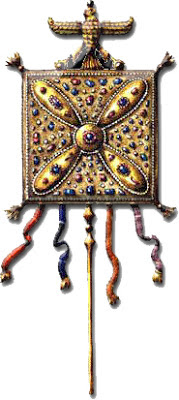Close your eyes and pretend this is a fairy tale, because it certainly sounds like one. I have patched this story together from history books, flag books and online references that are translations of translations.
 |
| Kaveh's bejewelled apron. |
Once upon a time--about 800 B.C.--there lived a blacksmith named Kaveh. He lived in the faraway kingdom of Persia, which covered what is now Iran and parts of Turkey and Turkmenistan. Like many of his fellow citizens, he feared that his country was being repressed by the invader Mesopotamian king, whose name meant "the man with 10,000 horses".
Kaveh had lost his sons to the invader's repression and he feared that his country was doing nothing to defend itself.
When the citizens of Persia were forced to sign a document pledging allegiance to this evil outside king, Kaveh refused. He tore up the document and strode from the palace.
Kaveh gave an impassioned speech in the market square and soon the crowd swelled. To make his point, he took off his blacksmith's apron. He hung it on a long lance and hoisted it above his head and above the crowd. They roared in approval.
Historians say that the apron represented the commonality of humanity in Persia and was instantly recognized by the people as a symbol of their sovereignty. They marched to petition the hero Fereydoun to lead them into battle.
Fereydoun could hear them coming, of course. He too recognized the blacksmith's apron for what it was--and what it meant. He not only embraced the symbol and the sentiment of the people, he made the apron his battle banner. He ordered that it should be stitched with gold and jewels and ribbons; Kaveh himself was to carry it into the battle.
 |
| An old postage stamp shows Kaveh and his banner. |
An Italian translation of the ancient story says that "Fereydoun kept the holy fire in one hand, the other controlling (his) fast horse. The glorious Banner of Kaveh was carried in front of him, and the land all about was covered (with its) yellow, red and violet reflections."
As the Persians marched to battle, Kaveh's apron sparkled in the sun and boasted a rainbow of colors, but at its core was the humble and worn leather apron. Of course, the invader was banished and Fereydoun became the king.
The banner became known as the Derafsh Kaviani ("the flag of Kaveh") and would become the flag that would lead Persia into battle for centuries to come. Every new ruler would add jewels or banners to the original flag as part of his coronation.
What became of Kaveh's bejewelled apron? The Italian source tells us: When it was taken by Arabs at Kadesia battle (A.D.637) its dimensions (had grown to) 22 by 15 feet. The Arab soldier who took it got as a prize the armor of the fallen Persian army commander and about 30,000 gold coins. The banner, which had led the Persian forces for 1,434 years, was stripped of its precious jewels and what remained of the apron was torn into pieces. Bits of it were distributed among the victorious Arab soldiers to keep as a remembrance of the solemn destruction of the Persian dream.
Persia became part of the Islamic world when the blacksmith's apron fell.
Perhaps some bits of the apron are still alive, somewhere. I know that the legend lives on and that the symbol of Kaveh's banner is still alive in Persian culture. I hope this little story helps keep Kaveh's banner waving, in the human imagination if not in real life.
And if you're a blacksmith, farrier or hoof trimmer, when you take your apron off after your last horse today, do me a favor and wave your apron in the air. Just for the heck of it. And smile for Kaveh when you do.
To learn more:
Kaveh Ahangar, historical Iranian sites and people
And if you're a blacksmith, farrier or hoof trimmer, when you take your apron off after your last horse today, do me a favor and wave your apron in the air. Just for the heck of it. And smile for Kaveh when you do.
To learn more:
Kaveh Ahangar, historical Iranian sites and people
Special thanks to the late renowned vexillologist, Dr. Whitney Smith, who inspired this research.
Follow Hoofcare + Lameness on Twitter: @HoofBlog
Read this blog's headlines on the Hoofcare + Lameness Facebook Page
Read this blog's headlines on the Hoofcare + Lameness Facebook Page
Disclosure of Material Connection: The Hoof Blog (Hoofcare Publishing) has not received any direct compensation for writing this post. Hoofcare Publishing has no material connection to the brands, products, or services mentioned, other than products and services of Hoofcare Publishing. I am disclosing this in accordance with the Federal Trade Commission’s 16 CFR, Part 255: Guides Concerning the Use of Endorsements and Testimonials in Advertising.

